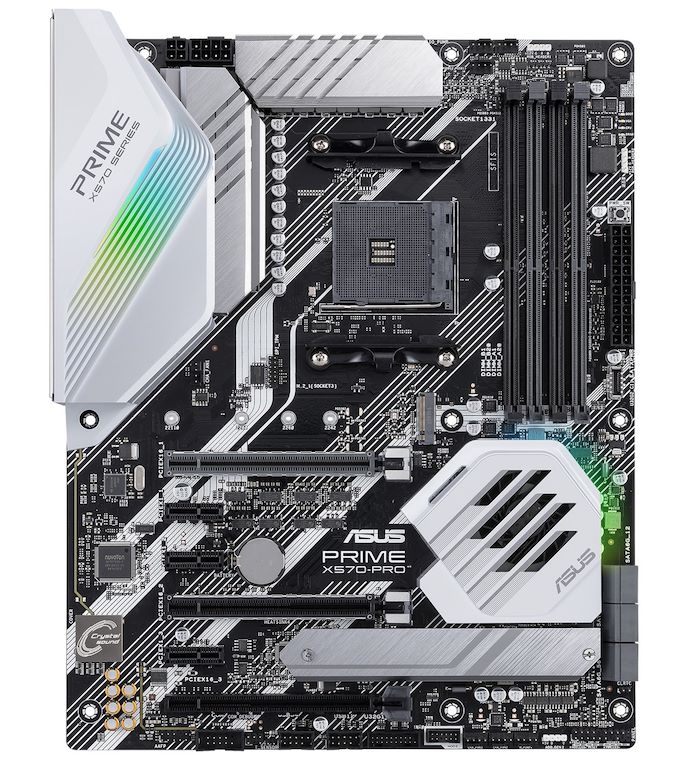The AMD X570 Motherboard Overview: Over 35+ Motherboards Analyzed
by Gavin Bonshor on July 9, 2019 8:00 AM ESTASUS Prime X570-Pro
Moving onto the ASUS Prime series of X570 motherboards, the ASUS Prime X570-Pro represents the more feature-laden of two ATX sized models; the other being the ASUS Prime X570-P. The ASUS Prime X570-Pro represents its less aggressive and non-gaming Prime range with a more subtle white and black aesthetic. The most notable aspects of the feature set include a Realtek S1220A HD audio codec, Gigabit NIC, and support for up to 128 GB of DDR4 memory.
The ASUS Prime X570-Pro offers three full-length PCIe 4.0 slots which run at x16, x8/x8, and x8/x8/x4. This allows for users to use two-way NVIDIA SLI and up to three-way AMD Crossfire multi-graphics card setups. Also present is three PCIe 4.0 x1 slots, with the board's storage capabilities coming through two PCIe 4.0 x4 M.2 slots, with the bottom slot coming with a heatsink; there are also six SATA ports with support for RAID 0, 1 and 10 arrays. In the top right-hand corner is four memory slots with support for up to 128 GB which allows users to install the 32 GB UDIMMs that has started making its way onto the market.
On the rear panel, the ASUS Prime X570-Pro includes three USB 3.1 G2 Type-A, one USB 3.1 G2 Type-C, and four USB 3.1 G1 Type-A ports. Adopters of AMD's impending Ryzen 3000 APUs and the Ryzen 2400/2200G will appreciate the HDMI and DisplayPort video outputs. There is also a PS/2 keyboard and mouse combo port, an Intel I211-AT Gigabit powered Ethernet port, and five 3.5 mm audio jacks and S/PDIF optical output driven by a Realtek S1220A HD audio codec.
The ASUS Prime X570-Pro has an MSRP of $250 and is more suited to users looking to avoid the swathe of gaming-themed models on the market. What the Prime series offers is elegant and neutral designs, which would actually look quite good with some RGB to make the white rear panel cover pop. There's support for two-way NVIDIA SLI and three-way AMD CrossFire too so users looking to build a more subtly styled gaming system can do so.












225 Comments
View All Comments
abufrejoval - Tuesday, July 9, 2019 - link
It's amazing how quickly you run out of PCIe lanes, when you don't have switches to multiplex and translate between PCIe revisions and lanes (e.g. PCIe v4 x2 <-> PCIe v2 x8).I find myself using USB 3.x NBase-T NICs and NVMe adapters, simply because they *do* switch.
Bensam123 - Tuesday, July 9, 2019 - link
Maybe a bit more depth on the power delivery page. I have absolutely no idea how to go about parsing what's there. More chokes is better? What denotes a power phase?A5 - Tuesday, July 9, 2019 - link
+1. Some analysis of that information would be helpful.MrSpadge - Tuesday, July 9, 2019 - link
+1bunkle - Wednesday, July 10, 2019 - link
The controller column includes the total number of phases supported split between CPU cores and SoC e.g. (6+1) = 6 CPU phase and 1 SoC phase. More is *usually* better but has diminishing returns regarding tighter and tighter voltage regulation. Some controllers are better than others (can operate at high frequency e.g. 500KHz v 1000KHz, include other features to improve performance) mitigating the need for more phases.Each phase is a buck converter comprised of a low/high side MOSFET (can be integrated in a single package) and choke. Some controllers can support doubling up the PWM signal to driver more MOSFETs. Doublers can also be added as discrete components if not built into the controller.
Current rating of the MOSFET (e.g. Sic639=40A IR3555=60A) indicates the total power deliverable. MOSFETs are not 100% efficient and vary in efficiency. The more current they provide the hotter they get and the less efficient they become, with better MOSFETs producing less heat for a given current. Thus using doubles can improve temperatures and efficiency without the benefits of the tighter voltage tolerance that *real* phases provide.
Hope that’s helpful!
bunkle - Wednesday, July 10, 2019 - link
A lot more detailed explanation: https://en.wikichip.org/wiki/voltage_regulator_mod...bug77 - Tuesday, July 9, 2019 - link
The description for AsRock X570(M) Pro4 says "5 jack + 1 SPDIF". Unfortunately, those boards lack SPDIF and only come with 3 jacks ;)Smell This - Tuesday, July 9, 2019 - link
I'm thinking the *ASRock Thunderbolt AIC* ...https://thunderbolttechnology.net/product/asrock-t...
would cover all your TBT peripheral needs, including optical.
DanNeely - Tuesday, July 9, 2019 - link
Do X570 boards still need an extra chip per USB port to support USB-C reversibility?The additional expense and needed PCB space were cited as among the reasons why earlier generation boards (IIRC both Intel and AMD) almost never had more than 1 C port; but it was never clear to me if that was an inherent implementation penalty for the C port or an artifact of Intel's tech stack being stalled out and AMD outsourcing to ASMedia which built the chipsets on an ancient (55nm) platform.
DigitalFreak - Tuesday, July 9, 2019 - link
Gavin - X370 and X470 only supported PCIe 2.0. The connection between the CPU and chipset was 3.0, but all the ports on the chipset were 2.0.